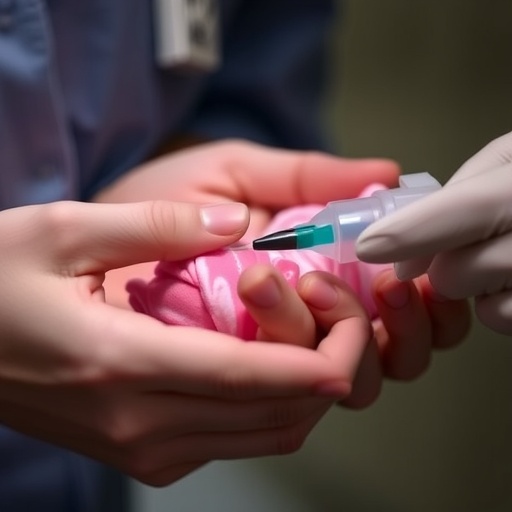
Credit: OU Medicine
OKLAHOMA CITY — More than 30% of children who are obese will eventually be diagnosed with non-alcoholic fatty liver disease, or NAFLD, a silently progressing condition that sometimes isn’t discovered until a child’s liver is stiffened with fibrosis.
Children born to obese mothers face a higher risk of developing NAFLD, but the exact reasons why remain unknown. Three researchers at Harold Hamm Diabetes Center at OU Medicine have been awarded a $2.3 million grant from the National Institutes of Health to investigate the role of the microbiome – the millions of bacteria in a person’s gut – and how the microbes passed from mother to child contribute to the onset of NAFLD. The researchers are also testing a nutritional compound for its potential to counter negative changes in the microbiome, thereby lowering the risk for NAFLD.
Babies receive their first microbes from their mother as they travel through the birth canal, breast feed, and have skin-to-skin contact. The microbiome plays a major role in how the immune system develops, beginning soon after birth. By age 3, a child’s microbiome is established, but things that disrupt its development in the first 1,000 days can alter the infant’s early immune system with significant consequences in later life. A primary suspect in that disruption is what the mother eats during pregnancy.
“A mother’s diet that causes her to be overweight will be transmitted to the infant in several ways. Knowing what those microbes are and figuring out how they disrupt the child’s immune system is the focus of this study,” said Jed Friedman, Ph.D., director of Hamm Diabetes Center and a principal investigator on the grant.
Friedman’s past research in this area helped him to attract the new federal grant. In his previous study, he took stool samples from 2-week-old infants who were born to obese mothers. Those samples, which contain the microbiome, were placed into mice that had no microbes of their own. As the mice got older, they became obese and experienced a change in their immune systems.
“That prompted us to start thinking about what these microbes are and what they’re doing,” Friedman said. “They’re coming from the mother in some way, but they’re leaking out of the infants’ microbiome and changing their immune system and making them gain weight. There’s a super-highway from the gut to your liver. So anything that leaks out of the gut travels straight to the liver. Your liver is a prime target for these microbes.”
Friedman’s current study will go a step further to determine how much of an infant’s microbiome disruption can be attributed to a mother’s diet during pregnancy vs. what the baby takes in during breastfeeding. Mice born to an obese mother will be placed with healthy-weight mice to breastfeed, and their immune system development will be monitored, he said.
The human microbiome is sometimes called the “undiscovered community within,” Friedman said, because it is 10 times the size of the human genome and extremely complicated because of how microbes act and communicate with each other. But for all its complexities, researchers have discovered ways to create a healthier microbiome, such using probiotics in children who have immune conditions like allergies, he said.
Part of this study will test the nutritional compound pyrroloquinoline quinone, or PQQ, for its ability to improve the microbiome. PQQ is an antioxidant found in green, leafy vegetables and, among other things, human breast milk, Friedman said. In the study, his team will investigate whether PQQ can counteract the microbial factors that lead to NAFLD.
“About 50% of women of reproductive age in the United States are overweight or obese, and of the 30% of obese children who are diagnosed with NAFLD, about 20% will be have advanced disease by the time it is discovered,” Friedman said. “The diagnosis represents a lifelong struggle, and there are no treatments except major lifestyle changes. That’s why we want to catch it before it starts.”
Friedman’s co-principal investigators on the grant are Karen Jonscher, Ph.D., who brings expertise with PQQ, and Kenneth Jones, Ph.D., who contributes a wealth of experience in laboratory testing, including single-cell RNA sequencing to capture images of the liver and its many cell types.
Research reported in this press release is supported by the National Institute of Diabetes and Digestive and Kidney Diseases, a component of the National Institutes of Health, under the award number 1R01DK121951-01A1.
###
HAROLD HAMM DIABETES CENTER
Harold Hamm Diabetes Center is committed to curing diabetes and ending the diabetes pandemic in the 21st century. It is among the world’s largest and most comprehensive institutions of its kind, integrating top-flight academic research with clinical care and disease prevention. The center oversees the world’s top research prize in the diabetes field. It has facilities in Oklahoma City and Tulsa as well as affiliated sites across the state, including partnerships with Native American communities. An innovative range of services includes support groups, cooking classes, lifestyle-intervention programs, and a summer camp for children and teens. For more information, visit hammdiabetescenter.org.
OU MEDICINE
OU Medicine — along with its academic partner, the University of Oklahoma Health Sciences Center — is the state’s only comprehensive academic health system of hospitals, clinics and centers of excellence. With 11,000 employees and more than 1,300 physicians and advanced practice providers, OU Medicine is home to Oklahoma’s largest physician network with a complete range of specialty care. OU Medicine serves Oklahoma and the region with the state’s only freestanding children’s hospital, the only National Cancer Institute-Designated Stephenson Cancer Center and Oklahoma’s flagship hospital, which serves as the state’s only Level 1 trauma center. OU Medicine is the No. 1 ranked hospital system in Oklahoma, and its oncology program at Stephenson Cancer Center and OU Medical Center ranked in the Top 50 in the nation, in the 2019-2020 rankings released by U.S. News & World Report. OU Medicine was also ranked by U.S. News & World Report as high performing in four specialties: Ophthalmology in partnership with Dean McGee Eye Institute, Colon Surgery, COPD and Congestive Heart Failure. OU Medicine’s mission is to lead healthcare in patient care, education and research. To learn more, visit oumedicine.com.
Media Contact
April Sandefer
[email protected]





